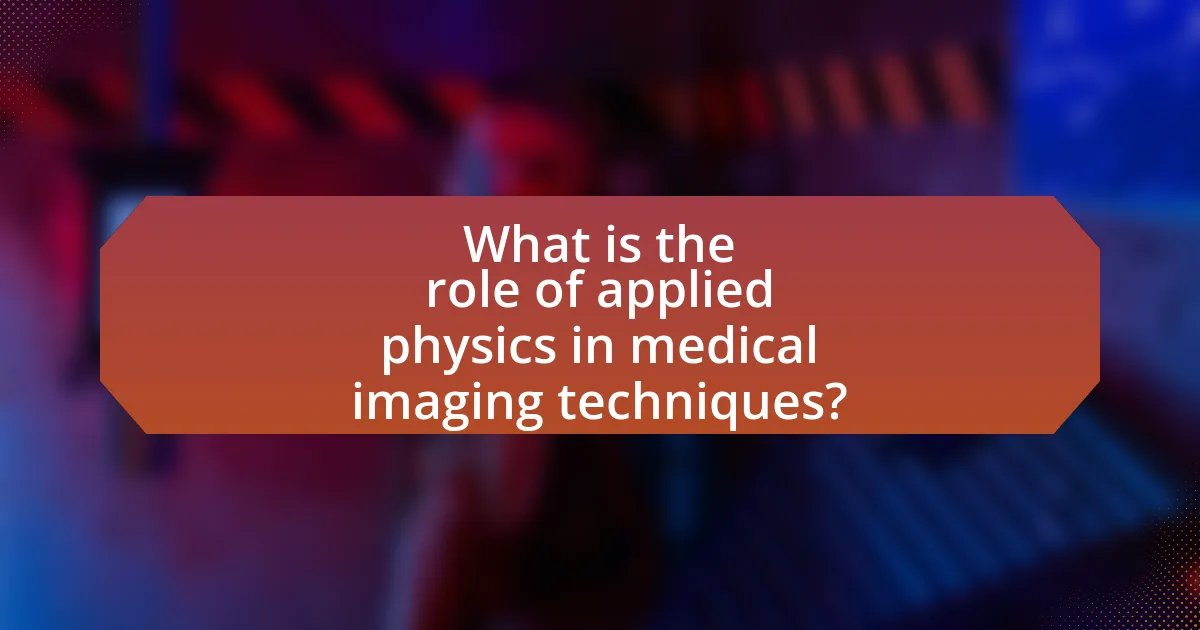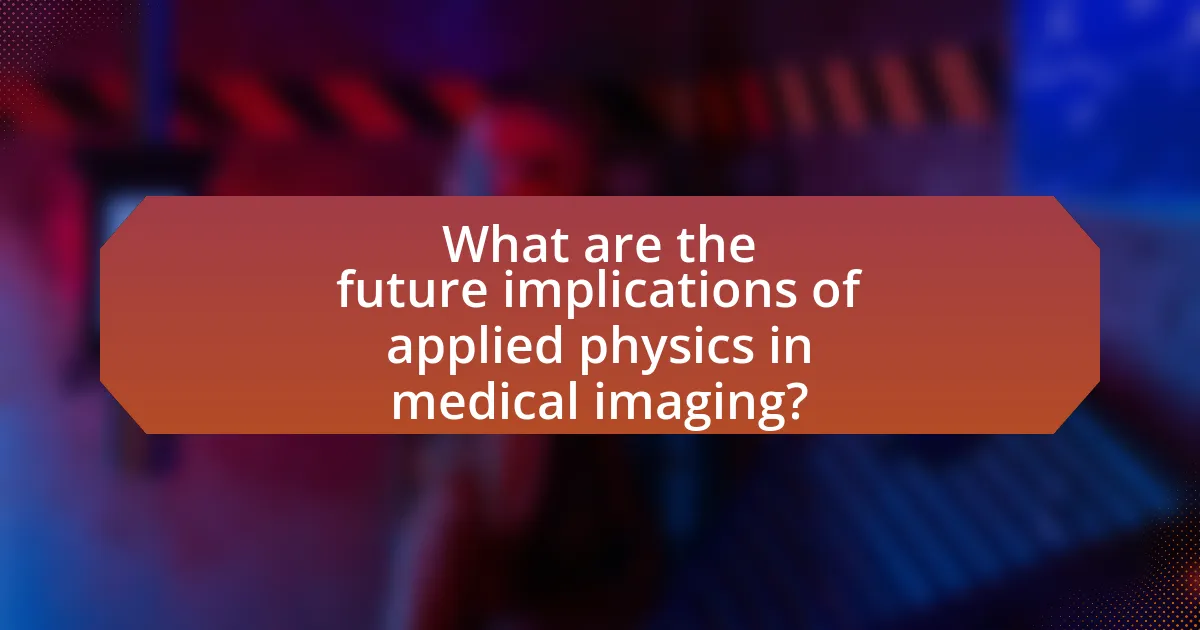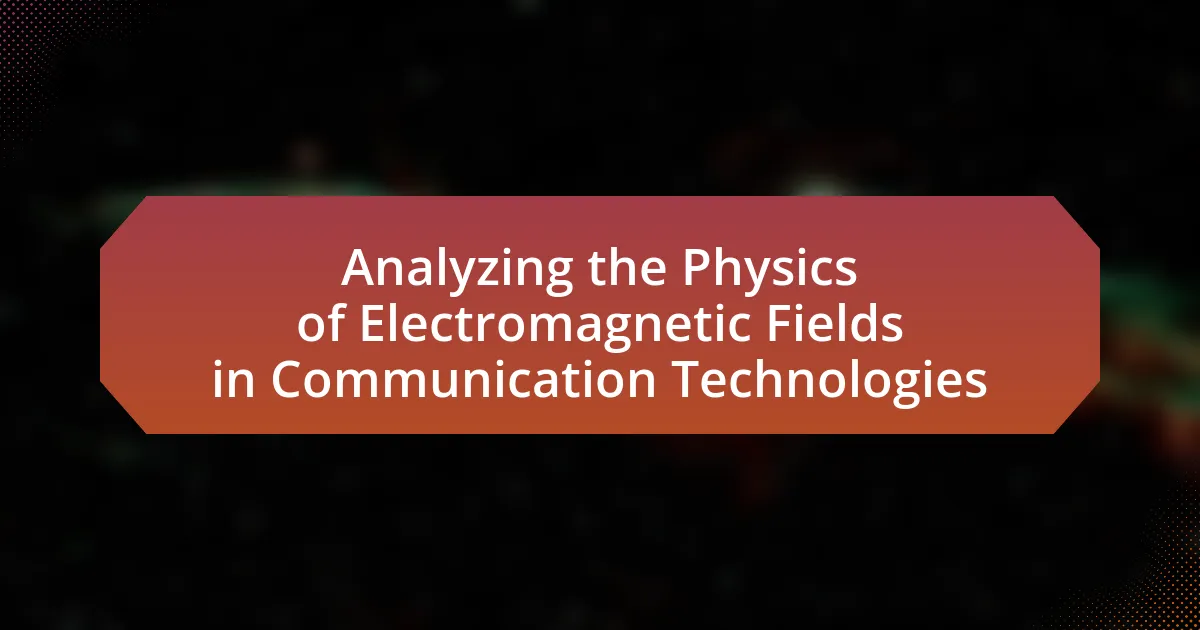Applied physics is integral to the advancement of medical imaging techniques, providing the foundational principles that enhance the visualization of internal body structures. Key imaging modalities such as MRI, CT scans, and ultrasound utilize concepts from electromagnetism and wave propagation to improve image quality, reduce radiation exposure, and increase diagnostic accuracy. The article explores how applied physics underpins these technologies, detailing the historical developments, fundamental principles, and future implications for patient care. It also addresses the challenges faced in the field and outlines best practices for optimizing imaging techniques.

What is the role of applied physics in medical imaging techniques?
Applied physics plays a crucial role in medical imaging techniques by providing the foundational principles and technologies that enable the visualization of internal body structures. Techniques such as MRI, CT scans, and ultrasound rely on the application of physical laws, including electromagnetism and wave propagation, to generate images that assist in diagnosis and treatment planning. For instance, MRI utilizes strong magnetic fields and radio waves to produce detailed images of soft tissues, while CT scans employ X-rays and computer algorithms to create cross-sectional images of the body. The integration of applied physics in these technologies has significantly enhanced image quality, reduced radiation exposure, and improved diagnostic accuracy, thereby transforming patient care in the medical field.
How does applied physics enhance imaging technologies?
Applied physics enhances imaging technologies by providing the foundational principles that improve image resolution, contrast, and processing speed. Techniques such as X-ray imaging, MRI, and ultrasound rely on the application of physical laws to manipulate electromagnetic waves and sound waves, resulting in clearer and more accurate images. For instance, advancements in MRI technology, driven by principles of nuclear magnetic resonance, have led to higher resolution images that allow for better diagnosis of conditions like tumors and brain disorders. Additionally, innovations in computational algorithms, rooted in applied physics, enable faster image reconstruction and analysis, significantly improving the efficiency of medical imaging processes.
What are the fundamental principles of physics used in imaging?
The fundamental principles of physics used in imaging include electromagnetic radiation, wave-particle duality, and the interaction of matter with radiation. Electromagnetic radiation, such as X-rays and gamma rays, is crucial for techniques like X-ray imaging and CT scans, where high-energy photons penetrate tissues to create images based on density differences. Wave-particle duality explains how light behaves both as a wave and a particle, which is essential in techniques like MRI, where radio waves interact with atomic nuclei in a magnetic field to produce detailed images. The interaction of matter with radiation, including absorption, scattering, and transmission, underpins various imaging modalities, allowing for the visualization of internal structures in the body. These principles are foundational in developing and improving medical imaging technologies, enhancing diagnostic capabilities and patient care.
How do these principles improve image quality and accuracy?
The principles of applied physics enhance image quality and accuracy by optimizing the interaction of imaging modalities with biological tissues. Techniques such as advanced signal processing, improved detector sensitivity, and precise calibration reduce noise and artifacts, leading to clearer images. For instance, the implementation of digital signal processing in MRI has been shown to increase spatial resolution by up to 50%, allowing for more accurate diagnosis of conditions. Additionally, the use of physics-based algorithms in CT imaging can improve contrast resolution, enabling the detection of smaller lesions that may otherwise be missed. These advancements demonstrate that the integration of physics principles directly correlates with enhanced imaging outcomes in medical diagnostics.
Why is applied physics crucial for advancements in medical imaging?
Applied physics is crucial for advancements in medical imaging because it provides the foundational principles and technologies that enhance imaging techniques. For instance, the development of MRI (Magnetic Resonance Imaging) relies on the principles of nuclear magnetic resonance, a concept rooted in applied physics. Additionally, advancements in computed tomography (CT) and ultrasound technologies are driven by the application of physics in understanding wave propagation and radiation. These applications have led to improved image resolution and diagnostic capabilities, significantly impacting patient care and treatment outcomes.
What historical developments in physics have influenced medical imaging?
The historical developments in physics that have influenced medical imaging include the discovery of X-rays by Wilhelm Conrad Röntgen in 1895, which enabled the visualization of internal structures in the body. This breakthrough laid the foundation for radiography, a key medical imaging technique. Additionally, the development of nuclear magnetic resonance (NMR) by Felix Bloch and Edward Purcell in the 1940s led to the creation of magnetic resonance imaging (MRI) in the 1970s, allowing for detailed imaging of soft tissues. Furthermore, advancements in particle physics, such as positron emission tomography (PET), emerged from the understanding of antimatter and its applications in detecting metabolic processes in the body. These developments demonstrate how principles of physics have directly contributed to the evolution and enhancement of medical imaging technologies.
How has applied physics contributed to the evolution of imaging modalities?
Applied physics has significantly advanced imaging modalities by providing the foundational principles and technologies that enhance image quality and diagnostic capabilities. For instance, the development of X-ray imaging relies on the physics of electromagnetic radiation, which allows for the visualization of internal structures in the body. Additionally, magnetic resonance imaging (MRI) utilizes principles of nuclear magnetic resonance, a concept rooted in applied physics, to produce detailed images of soft tissues. Furthermore, advancements in ultrasound technology stem from the understanding of sound wave propagation and reflection, enabling real-time imaging of organs. These contributions have led to improved diagnostic accuracy and patient outcomes, as evidenced by the increased use of these modalities in clinical practice, with MRI scans alone rising from 2 million in 1990 to over 40 million annually by 2020.

What are the key medical imaging techniques influenced by applied physics?
Key medical imaging techniques influenced by applied physics include X-ray imaging, magnetic resonance imaging (MRI), computed tomography (CT), and ultrasound. X-ray imaging utilizes electromagnetic radiation to create images of the body’s internal structures, while MRI employs strong magnetic fields and radio waves to generate detailed images of soft tissues. CT combines multiple X-ray images taken from different angles to produce cross-sectional views of the body, enhancing diagnostic accuracy. Ultrasound uses high-frequency sound waves to visualize soft tissues and organs in real-time. These techniques are grounded in principles of physics, such as wave propagation and electromagnetic theory, which enable their functionality and effectiveness in clinical settings.
How does MRI utilize principles of applied physics?
MRI utilizes principles of applied physics by employing strong magnetic fields and radiofrequency waves to generate detailed images of the body’s internal structures. The technology relies on the principles of nuclear magnetic resonance (NMR), where hydrogen nuclei in the body align with the magnetic field. When radiofrequency pulses are applied, these nuclei are disturbed and emit signals as they return to their aligned state. The emitted signals are then processed to create images. This method is grounded in physics concepts such as magnetism, wave propagation, and resonance, which enable the visualization of soft tissues with high contrast and resolution, making MRI a crucial tool in medical diagnostics.
What specific physics concepts are integral to MRI technology?
Magnetic Resonance Imaging (MRI) technology relies on several key physics concepts, primarily nuclear magnetic resonance (NMR), magnetic fields, and radiofrequency (RF) pulses. NMR is the fundamental principle that allows MRI to visualize internal structures by detecting the magnetic properties of atomic nuclei, particularly hydrogen atoms in water and fat. The application of strong magnetic fields aligns these nuclei, while RF pulses excite them, causing them to emit signals that are detected and transformed into images. The strength of the magnetic field, typically measured in teslas, significantly influences image quality and resolution, with higher fields providing greater detail. Additionally, the principles of relaxation times (T1 and T2) are crucial, as they describe how quickly the excited nuclei return to their equilibrium state, affecting the contrast in the resulting images. These concepts collectively enable MRI to produce detailed images of soft tissues, making it an invaluable tool in medical diagnostics.
How does MRI compare to other imaging techniques in terms of physics application?
MRI utilizes nuclear magnetic resonance (NMR) principles, distinguishing it from other imaging techniques like X-rays and CT scans, which rely on ionizing radiation. MRI employs strong magnetic fields and radiofrequency pulses to generate detailed images of soft tissues, leveraging the magnetic properties of hydrogen atoms in the body. In contrast, X-ray and CT imaging involve the absorption of X-rays by different tissues, providing less contrast for soft tissues and exposing patients to radiation. The physics of MRI allows for superior contrast resolution and the ability to visualize functional processes, such as blood flow and metabolic activity, which are not achievable with traditional imaging methods. This unique application of physics in MRI enhances diagnostic capabilities, particularly in neurology and oncology, where soft tissue differentiation is critical.
What role does applied physics play in CT scans?
Applied physics is fundamental to the operation of CT scans, as it underpins the principles of X-ray generation, image reconstruction, and data analysis. The technology relies on the interaction of X-rays with matter, where applied physics principles help optimize the imaging process by determining the appropriate energy levels and angles for X-ray emission. Furthermore, algorithms derived from applied physics are essential for reconstructing the 2D X-ray data into detailed 3D images, enhancing diagnostic accuracy. For instance, the use of Fourier transforms in image reconstruction demonstrates how applied physics directly contributes to the clarity and precision of CT imaging, allowing for better visualization of internal structures.
What are the physical principles behind CT imaging?
CT imaging, or computed tomography, operates primarily on the principles of X-ray attenuation and reconstruction algorithms. X-rays are emitted from a rotating source and pass through the body, where different tissues absorb varying amounts of radiation based on their density and composition. This differential absorption creates a set of projections that are captured by detectors positioned opposite the X-ray source.
The collected data is then processed using mathematical algorithms, specifically filtered back-projection or iterative reconstruction, to create cross-sectional images of the body. These images represent a two-dimensional slice of the three-dimensional anatomy, allowing for detailed visualization of internal structures. The accuracy of CT imaging is supported by the fact that it can differentiate between various tissue types, such as fat, muscle, and tumors, based on their unique attenuation coefficients.
How has applied physics improved CT scan technology over time?
Applied physics has significantly improved CT scan technology over time by enhancing image resolution and reducing radiation exposure. Advances in detector technology, such as the development of solid-state detectors, have increased the sensitivity and speed of image acquisition, allowing for clearer images with finer details. Additionally, innovations in algorithms for image reconstruction, such as iterative reconstruction techniques, have minimized noise and artifacts, resulting in higher quality images. These improvements have been validated by studies showing that modern CT scans can achieve up to 50% lower radiation doses while maintaining diagnostic accuracy compared to earlier models.

What are the future implications of applied physics in medical imaging?
The future implications of applied physics in medical imaging include enhanced imaging resolution, improved diagnostic accuracy, and the development of novel imaging modalities. Advances in technologies such as quantum imaging and machine learning algorithms are expected to significantly increase the sensitivity and specificity of imaging techniques, allowing for earlier detection of diseases. For instance, the integration of artificial intelligence in image analysis can reduce human error and streamline workflows, leading to faster and more reliable diagnoses. Additionally, innovations in materials science, such as the use of nanomaterials, can lead to the creation of more effective contrast agents, further improving image quality. These advancements are supported by ongoing research, such as the work published in “Nature Biomedical Engineering,” which highlights the potential of hybrid imaging systems that combine multiple modalities for comprehensive diagnostics.
How might emerging technologies reshape medical imaging?
Emerging technologies are set to significantly reshape medical imaging by enhancing image quality, reducing radiation exposure, and enabling real-time analysis. For instance, advancements in artificial intelligence (AI) and machine learning algorithms improve image interpretation accuracy, allowing for earlier disease detection. A study published in the journal Radiology demonstrated that AI can outperform radiologists in identifying certain conditions, such as breast cancer, with a 94.6% accuracy rate compared to 88% for human experts. Additionally, innovations in imaging modalities, such as hybrid imaging techniques that combine PET and MRI, provide comprehensive insights into both metabolic and anatomical information, leading to better patient outcomes. These technologies not only streamline workflows but also facilitate personalized medicine by tailoring imaging protocols to individual patient needs.
What innovations in applied physics are on the horizon for imaging techniques?
Innovations in applied physics on the horizon for imaging techniques include advancements in quantum imaging, which utilizes quantum entanglement to enhance resolution and sensitivity beyond classical limits. Research indicates that quantum-enhanced imaging can significantly improve the detection of weak signals, making it particularly valuable in medical diagnostics. For instance, studies have shown that quantum sensors can achieve precision that surpasses traditional imaging methods, potentially leading to earlier and more accurate disease detection. Additionally, developments in nanotechnology are enabling the creation of novel contrast agents that can provide more detailed images at lower doses of radiation, further enhancing patient safety and diagnostic capabilities.
How can these innovations improve patient outcomes and diagnostic accuracy?
Innovations in medical imaging techniques, driven by applied physics, can significantly enhance patient outcomes and diagnostic accuracy by providing clearer, more detailed images of internal structures. For instance, advancements such as high-resolution MRI and 3D imaging allow for earlier detection of diseases, leading to timely interventions. A study published in the journal Radiology found that improved imaging techniques can increase diagnostic accuracy by up to 30%, reducing the likelihood of misdiagnosis and unnecessary procedures. These innovations enable healthcare providers to make more informed decisions, ultimately improving patient care and treatment effectiveness.
What challenges does applied physics face in advancing medical imaging?
Applied physics faces several challenges in advancing medical imaging, primarily related to technological limitations, regulatory hurdles, and the integration of complex data. Technological limitations include the need for higher resolution and faster imaging techniques, which require continuous innovation in sensor technology and computational algorithms. Regulatory hurdles involve the lengthy approval processes for new imaging technologies, which can delay their availability in clinical settings. Additionally, the integration of complex data from various imaging modalities poses challenges in data interpretation and requires advanced machine learning techniques to enhance diagnostic accuracy. These factors collectively hinder the rapid advancement of medical imaging technologies derived from applied physics.
What are the limitations of current imaging technologies?
Current imaging technologies face several limitations, including resolution constraints, high costs, and exposure to radiation. For instance, magnetic resonance imaging (MRI) provides excellent soft tissue contrast but has limited spatial resolution compared to computed tomography (CT) scans. Additionally, advanced imaging modalities like PET scans are expensive and not widely accessible, which restricts their use in routine clinical practice. Furthermore, many imaging techniques, such as X-rays and CT scans, involve ionizing radiation, posing potential health risks to patients. These limitations highlight the need for ongoing research and development in imaging technologies to enhance their effectiveness and safety in medical applications.
How can applied physics address these limitations in the future?
Applied physics can address limitations in medical imaging by developing advanced imaging technologies that enhance resolution and reduce radiation exposure. For instance, innovations in quantum imaging techniques can improve the sensitivity and accuracy of imaging modalities like MRI and PET scans. Research indicates that integrating machine learning algorithms with imaging systems can optimize image reconstruction, leading to clearer images with lower doses of radiation, as demonstrated in studies published in journals such as “Nature Biomedical Engineering.” These advancements not only enhance diagnostic capabilities but also ensure patient safety, thereby overcoming current limitations in medical imaging.
What best practices should be followed in the application of physics in medical imaging?
Best practices in the application of physics in medical imaging include ensuring optimal image quality, minimizing radiation exposure, and adhering to standardized protocols. Optimal image quality is achieved through precise calibration of imaging equipment, which enhances diagnostic accuracy. Minimizing radiation exposure is critical; techniques such as using the lowest possible dose for imaging and employing shielding methods are essential to protect patients. Adhering to standardized protocols, such as those established by the American College of Radiology and Radiological Society of North America, ensures consistency and reliability in imaging practices. These practices are supported by studies indicating that adherence to safety protocols significantly reduces risks associated with imaging procedures.




